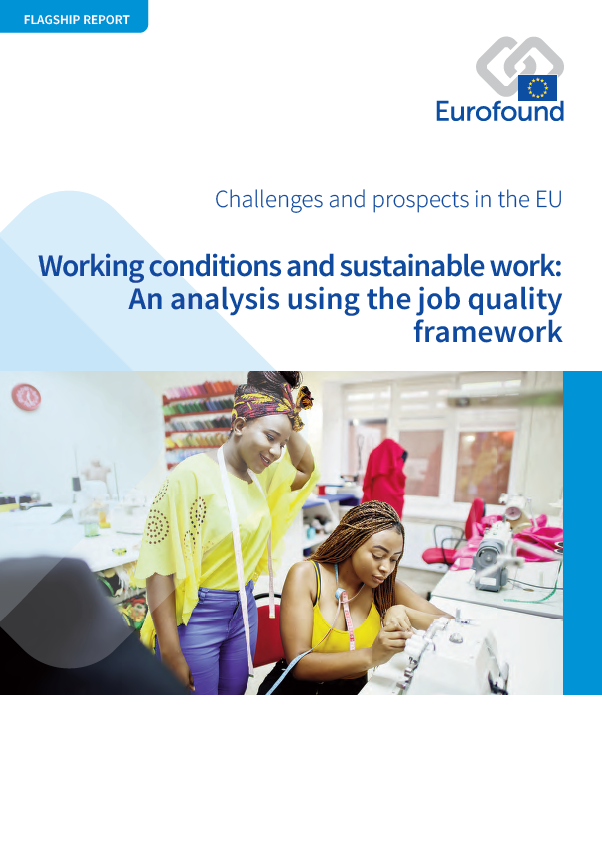
Este relatório emblemático resume as principais conclusões da investigação da Eurofound sobre as condições de trabalho, realizada no período de programação 2017-2020. Faz um balanço dos progressos alcançados desde 2000 na melhoria das condições de trabalho e examina se todos os trabalhadores beneficiaram de forma equitativa de mudanças positivas. Salienta quais são os grupos mais expostos ao risco de vivenciarem más condições de trabalho e serem deixados para trás. Dadas as mudanças no mundo do trabalho, são identificados desafios emergentes para a qualidade do emprego. O relatório também fornece medidas que poderiam conduzir a uma melhoria do trabalho e à consecução de condições de trabalho justas para todos na UE.
A análise mostra que, em geral, a qualidade do emprego na UE está a melhorar, se bem que lentamente. No entanto, nem todos os trabalhadores beneficiam em igual medida. Além disso, o género, a idade e o estatuto contratual têm uma influência significativa nas condições de trabalho individuais. E, embora a digitalização ajude a resolver alguns problemas em matéria de qualidade do emprego, ela também cria novos desafios. A pandemia da COVID-19 agravou as tendências, reforçando as preocupações e realçando a importância de alcançar a qualidade do emprego para todos.
Key findings
Em média, os trabalhadores da UE usufruem hoje de melhores condições de trabalho do que no início do milénio. A qualidade do tempo de trabalho melhorou claramente e o ambiente físico também é melhor, especialmente nas situações em que é mais importante: em profissões com elevada exposição a riscos físicos.
Os empregos exigem hoje mais competências e oferecem mais autonomia do que no passado. Isto reflete-se numa melhoria do índice de competências e discrição.
O desenvolvimento das competências dos trabalhadores é dificultado pela desigualdade de acesso e de participação em formação remunerada pelo empregador. Os trabalhadores mais velhos participam menos na formação e existe uma diferença crescente no acesso entre trabalhadores com diferentes estatutos contratuais (contratos a tempo inteiro versus a tempo parcial, e contratos sem termo versus contratos a termo).
A persistência da segregação de géneros no mercado de trabalho reflete-se em diferenças na qualidade do emprego entre homens e mulheres. Mas não há um vencedor global. As diferenças de género podem também ser prejudiciais para os homens, por exemplo no que se refere ao ambiente físico.
Embora as perspetivas de carreira tenham geralmente melhorado para homens e mulheres, os homens têm mantido a sua vantagem nesta dimensão da qualidade do emprego. A desigualdade na partilha das responsabilidades de prestação de cuidados, que se traduz em interrupções de carreira mais prolongadas e em horários de trabalho diferentes para as mulheres, é a causa provável.
Based on the European Working Conditions Survey (EWCS) 2015 analysis, the data below accompany Eurofound's flagship report on working conditions and sustainable work and focus on job quality for different occupational profiles.
- Data: Job quality in the EU
The flagship report also has the following list of tables and figures.
List of tables
Table 1: Change in the composition of the workforce, EU27 and the UK, 2002–2019
Table 2: Elements of the job demands–resources model based on the EWCS
List of figures
Figure 1: The seven dimensions of job quality and the indicators composing each dimension
Figure 2: Indexed change in job quality indices, EU27 and the UK, 2000–2015
Figure 3: Physical environment index: mean and standard deviation, by occupational category, EU27 and the UK, 2000–2015
Figure 4: Work intensity index: mean and standard deviation, by sector, EU27 and the UK, 2000–2015
Figure 5: Work intensity index: mean and standard deviation, by country cluster, EU27 and the UK, 2000–2015
Figure 6: Skills and discretion index: mean and standard deviation, by occupational category, EU27 and the UK, 2000–2015
Figure 7: Skills and discretion index: mean and standard deviation, by country cluster, EU27 and the UK, 2000–2015
Figure 8: Participation in paid training (%), by employment and contractual status, EU27 and the UK, 2005–2015
Figure 9: Associations between working time quality and occupational category, by country cluster
Figure 10: Working time quality index: mean and standard deviation, by country cluster, EU27 and the UK, 2000–2015
Figure 11: Long working hours (%), by employment status, EU27 and the UK, 2000–2015
Figure 12: Prospects index: mean and standard deviation, by occupational category, EU27 and the UK, 2005–2015
Figure 13: Prospects index: mean and standard deviation, by country cluster, EU27 and the UK, 2005–2015
Figure 14: Scores on Prospects index, by employment and sociodemographic characteristics, EU27 and the UK, 2005 and 2015
Figure 15: Receipt of support from colleagues and managers (%), EU27 and the UK, 2005–2015
Figure 16: Receipt of support from colleagues and managers (%), by age group, EU27 and the UK, 2005 and 2015
Figure 17: Exposure to adverse social behaviour (%), by gender, EU27 and the UK, 2010 and 2015
Figure 18: Perception of fair pay (%), by Member State and the UK, 2005–2015
Figure 19: Perceived appropriateness of pay, by country cluster, EU27 and the UK, 2005–2015
Figure 20: Job quality profiles: Scores on seven job quality indices, EU27 and the UK, 2015
Figure 21: Distribution of workers according to job quality profiles, EU27 and the UK, 2015
Figure 22: Job quality profiles of men, by job quality indices, EU27 and the UK, 2015
Figure 23: Job quality profiles of women, by job quality indices, EU27 and the UK, 2015
Figure 24: Distribution of employees according to predominant gender in occupation (%), by gender, EU27 and the UK, 2010 and 2015
Figure 25: Gender of immediate manager (%), by worker’s gender, EU27 and the UK, 2005–2015
Figure 26: Female employees reporting good prospects for career advancement and gender gap (%), EU27 and the UK, 2005–2015
Figure 27: Good prospects for career advancement (%), by age and gender, EU27 and the UK, 2005–2015
Figure 28: Job insecurity according to predominant gender in occupation (%), by gender, EU27 and the UK, 2010 and 2015
Figure 29: Employability according to predominant gender in occupation (%), by gender, EU27 and the UK, 2010 and 2015
Figure 30: Employees reporting difficulty making ends meet according to occupation type (%), by gender, EU27 and the UK, 2015
Figure 31: Employees reporting difficulty making ends meet according to household type (%), by gender, EU27 and the UK, 2015
Figure 32: Employee experience of selected emotional demands (%), by gender, EU27 and the UK, 2010 and 2015
Figure 33: Average weekly working hours of employees across the life course, by gender, EU27 and the UK, 2015
Figure 34: Flexibility to take time off according to predominant gender in occupation (%), by gender, EU27 and the UK, 2010 and 2015
Figure 35: Additional components of earnings from main job (%), by gender, EU27 and the UK, 2005–2015
Figure 36: Employees’ perception of their work–life balance (%), by age, EU27 and the UK, 2015
Figure 37: Employees’ participation in training (%), by age and training classification, EU27 and the UK, 2015
Figure 38: Associations between demands and resources and workers’ health and well-being
Figure 39: Proportion of workers with flexitime schedules and engaged in TICTM (%), EU27 and the UK, 2015
Figure 40: Workers reporting work–life balance problems (%), by work arrangement and presence or absence of children, EU27 and the UK, 2015
Figure 41: Multiple-job holders as a proportion of total employment (%), by gender and country, EU27 and the UK, 2018
Figure 42: Job quality profiles of multiple-job holders’ main jobs, by gender, EU27 and the UK, 2015
Figure 43: Job quality of selected critical occupations in relation to the workforce average
Figure 44: Emotional demands on ISWs and extent of those demands (%), EU27 and the UK, 2015
- Number of pages
-
80
- Reference nº
-
EF20021
- ISBN
-
978-92-897-2150-9
- Catalogue nº
-
TJ-03-21-030-EN-N
- DOI
-
10.2806/938302
- Permalink
Members of Eurofound’s Management Board provide their reactions to and insights into Eurofound’s 2021 flagship report on Working conditions and sustainable work: An analysis using the job quality framework.
- Impact of the Covid-19 pandemic
Interview with Juha Antila, Head of Research and Development SAK, Central Organisation of Finnish Trade Unions.
- Digitalisation
Interview with Mario van Mierlo, Deputy Director, Social Affairs, The Dutch Confederation of Industry and Employers (VNO-NCW).
- Making work sustainable
Interview with Alain Piette, Ergonomist at the Belgian Federal Public Service Employment, Labour and Social Dialogue.
- Role of different actors in improving job quality
Interview with Rebekah Smith, Deputy Director for Social Affairs, BusinessEurope.
- Persisting challenges
Interview with Nelson Ferreira, Deputy General Inspector ACT, Portugal Labour Conditions Authority.
- Remote working
Interview with Esther Lynch, Deputy General Secretary of the European Trade Union Confederation (ETUC).
Cite this publication
Eurofound (2021), Working conditions and sustainable work: An analysis using the job quality framework, Challenges and prospects in the EU series, Publications Office of the European Union, Luxembourg.
